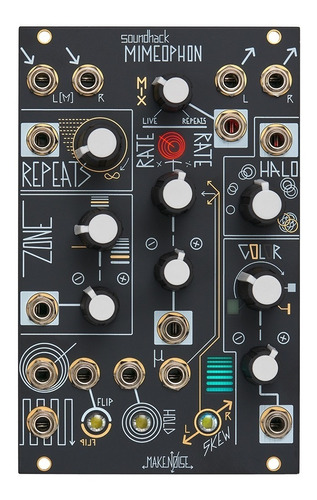IMPORTWAVECLMAKE NOISE MIMEOPHONMake Noise & soundhack's Mimeophon breaks the boundaries between all types of time-based effects, capable of everything from Karplus-Strong synthesis and flange effects to full-on delay and looping. Following in the footsteps of several of their previous digital modules, it might just make you reconsider what a delay effect is, and how it can be used.Another collaboration with soundhack's Tom Erbe, the Mimeophon is a synthesis tool based on exploiting the repetition of sonic material. A glance through its features seems to reveal an obvious kinship to the Echophon, Erbe-Verb, and Morphagene. It is a complex and well-considered time-based effect whose potential branches well beyond a simple label such as "delay" or "looper." Mimeophon's scale of operation is uncommonly wide: it can perform temporal processes as short as 1.3ms to as long as 41 seconds, making it just as useful as a flanger, for instance, as it is as a delay.Mimeophon offers stereo input and output (perfect for adding in line with a QPAS or Morphagene). It provides two primary controls related to perceived effect duration: Zone and Rate. Zone shifts the overall timescale, ranging from microsound to lengthy looping ranges. Best of all, altering Zone doesn't incur the Doppler shift effect associated with most delays: pitch information is preserved while timescale changes.If whooshy, wobbly delay modulation effects are what you want, though, don't fret: the Rate control can take you there. Complete with tempo sync (and clock division/multiplication), CV input, and a micro Rate input for subtler doppler modulation, Mimeophon's Rate control is the destination for more traditional delay-like effects. The Skew button also allows for temporally offset operation between the left and right audio channels, effectively allowing the Rate control to inversely affect each side for swirling spatial images and ping pong-like effects. The Rate output produces pulses at skewed tempi, allowing Mimeophon's repeat effect to act as a synchronization source for other devices.Users can utilize incoming gate signals for Flip and Hold, allowing for rhythmic engagement of reverse and freeze-like effects: altering the contents of entire zones, be they lengthy or minuscule.And then the true mysteries: Halo and Color. These controls work together with the Repeats control in order to create soundscapes whose characteristics gradually shift over time: Halo creates stereo smearing effects, while color focuses feedback into particular ranges for an evolving timbral focus. While what these controls actually do internally is not easy to describe, they are a huge part of Mimeophon's sound: a cascading, swirling universe of tones that breach between delay and reverb, clean repeats and murky smears.Complete with voltage control of all parameters (including wet/dry mix), Mimeophon is an inspiring and fresh addition to the Make Noise product line. Despite what might initially seem like overlap with modules like the Echophon, Erbe-Verb, and Morphagene, Mimeophon provides access to completely new ground: diffused echoes, reversed soundscapes, granular transformations, rhythmic repetitions, and lush halos await.MIMEOPHON FEATURESStereo multi-zone color audio repeaterDesigned in collaboration with Tom Erbe of Soundhack fameContinues the forward-thinking legacy of modules like Phonogene, Echophon, Erbe-Verb, and MorphagenePerfect for all sorts of time-based effects from Karplus-Strong to delays, microsound to lengthy loopsZone control provides access to nested layers of repeats, acting as a master timescale controlRate provides playback speed/Doppler-style "delay rate" controlSkew for offsetting left and right repeat ratesmicro Rate for subtler Doppler effectsFlip and Hold for reverse and freeze effectsRepeats, Halo, and Color interact to create effects that smear in space and change in spectral focus over timeGate output derived from Rate controlMono or stereo input with stereo outputCV or Gate control for all parameters
 Precio: $499900
Precio: $499900  Precio: $499900
Precio: $499900